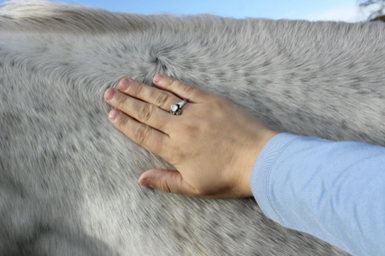By Paige Cerulli, Certified Equine Massage Therapist
A few weeks back we talked about the physical benefits that massage/posture prepping can have for your horse. Truth is, there are many additional benefits to massage, and the act of massaging your horse can teach you a lot. Consider the following information that you can learn by massaging your horse.
Learn About Equine Anatomy
As you learn to massage your horse, you will learn about equine anatomy. While it’s a great idea to look at some diagrams of the horse’s musculature and joints, you can learn quite a bit by just using your hands, too. As you massage your horse, trace the major muscle groups and feel the way that your hands naturally want to move. You will be able to feel the paths of the muscles, which can give you insight to how the horse’s body is constructed and functions.
Learn to Pay Attention to Details
Equine massage is all about the details. As you become experienced with massage, you will get better at noticing little details. Is there a slight twitch or hesitance as you move over a particular muscle? That could indicate a muscle strain or spasm. Does a muscle have an unusual feel to it, like it’s ropy or stringy? This often means that the muscle is tight and that an injury may have previously occurred.
Develop a Feel of What’s Normal for Your Horse
The more that you work on your horse, the more you’ll develop a feel of what’s normal for his body. Horses have very individual states of normalcy – what’s normal for your horse’s muscles might not be normal for another horse. As you get used to the average tension and feel of your horse’s body, you’ll be able to do quick “check-ups” by feeling his muscles and making sure that everything is normal.
Learn How to Spot Issues Early On
As you develop a feel of what’s normal for your horse, you’ll also learn how to spot potential issues early on. Rather than waiting until your horse is actively lame, you can learn to feel muscle tension in your horse’s shoulder or hind end which can progress to lameness if left untreated.
Learn How to Better Listen to What Your Horse Is Saying
Perhaps one of the most important lessons you’ll learn while posture prepping your horse is how to listen to what your horse is telling you. As you massage your horse, you will learn to better read his body language – is he cocking that hind leg because he’s comfortable or ready to kick? Is he raising his head because what you’re doing feels good or is he tensing up against pain? With time and experience, you will be able to pick up on the subtle changes in your horse’s body language to better gauge his comfort level and behavior.
Truth is, horses communicate with us constantly – we just don’t always know how to perceive the signals that our horses are giving off. Equine massage can fine-tune your perception skills, deepening your understanding of your horse and allowing you to better communicate with him.
Massage is a valuable tool for many reasons, and you can learn important skills by massaging your horse regularly. In short, massaging your horse can make you a better horseperson and can help you to take better care of your horse.

